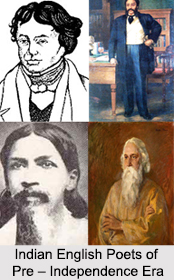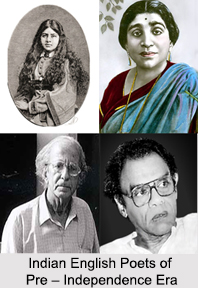 Indian English poetry has been one of the oldest parts of Indian English Literature and it represents the various developmental phases of multitudinous culture and society. The conflict between tradition and modernity at various levels like social, cultural, familiar, national and cosmopolitan is well marked in the works of these Indian English poets. The works of the Indian English poets can be divided into two phases, the pre - Independence era and the post - Independence era.
Indian English poetry has been one of the oldest parts of Indian English Literature and it represents the various developmental phases of multitudinous culture and society. The conflict between tradition and modernity at various levels like social, cultural, familiar, national and cosmopolitan is well marked in the works of these Indian English poets. The works of the Indian English poets can be divided into two phases, the pre - Independence era and the post - Independence era.
Indian English Poets of the Pre - Independence Era
The poems in the pre - Independence era were written in two parts, the first phase of the Indian poetry was the period of literary renaissance in India. Indian English poets like Henry Louis Vivian Derozio`s poems, Kasiprasad Ghose`s "The Shair or Minstrel and Other Poems", Michael Madhusudan Dutt`s "The Captive Lady", Manmohan Ghose`s "Love Songs and Elegies" are a testimony to the creative upsurge occasioned by the romantic spirit kindled by the literary renaissance. In this first phase, Toru Dutt alone among these romantic poets puts an emphasis on India and her heritage by putting into verse a large number of Indian legends.
These poets successfully gave a new direction to Indian poetry in English by writing on Indian history, myths and legends. The poets of 1850 to 1900 were trying to establish the imitative part of poetry, which followed the British Romantics and Victorian poets.
 In the second phase of the Indian poetry, the works of the Indian English poets was fraught with nationalism, spirituality and mysticism. Poets like Swami Vivekananda, Swami Ramtirtha, Swami Yogananda, Sri Aurbindo Ghosh and Rabindranath Tagore left a body of poetry which is glorious summation of India"s cultural spiritual and methodological heritage which dates back to the Vedas and the Upanishads. In their poetry they endeavoured to nativize English language in order to make it a befitting instrument for the expression of Indian sensibility. Female poets like Sarojini Naidu and Toru Dutt constitute a kind of watershed between these two phases, in that they share their predecessor"s individual nostalgia as well as their successor"s sense of crisis and quest of identity.
In the second phase of the Indian poetry, the works of the Indian English poets was fraught with nationalism, spirituality and mysticism. Poets like Swami Vivekananda, Swami Ramtirtha, Swami Yogananda, Sri Aurbindo Ghosh and Rabindranath Tagore left a body of poetry which is glorious summation of India"s cultural spiritual and methodological heritage which dates back to the Vedas and the Upanishads. In their poetry they endeavoured to nativize English language in order to make it a befitting instrument for the expression of Indian sensibility. Female poets like Sarojini Naidu and Toru Dutt constitute a kind of watershed between these two phases, in that they share their predecessor"s individual nostalgia as well as their successor"s sense of crisis and quest of identity.
Indian English Poets of the Post - Independence Era
Different from the first two phases of the pre - Independence era, the ethos of the post - Independence era is radically different. In the post - Independence era, the works of the Indian English poets reflected perspective and milieu. During this period, poets like Nissim Ezekiel, aptly known as the father of modern Indian poetry in English, P. Lal, Dom Moraes, A.K. Ramanujan, Pritish Nandy and Arun Kolatkar, among others came into the scene.
The poetry from this phase gradually transformed into the contemporary style of poetry which talked about the inner conflict, alienation, failure, frustration, loneliness, one"s relations with themselves and others, etc. It was from the 50s that the true sense of Indian poetry started to appear. It was in 1958 that P. Lal and his associates founded the Writers Workshop in Kolkata which became an effective forum for modernist poetry. The first modernist anthology was "Modern Indo-Anglian Poetry" (1958) edited by P. Lal and K. Raghavendra Rao.
The works of the Indian English poets are realistic and the poets are intellectually critical in the expression of their individualized experience.



















